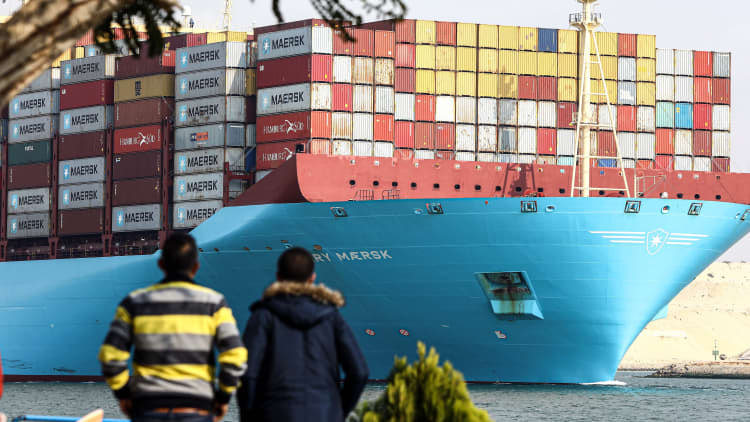A.P. Moller-Maersk says that based on progress made in the Port of Baltimore collapsed bridge clean-up, it may be able to set a timeline on returning to the port in the next week or so, and resumption of network services at the Baltimore port for the second-largest global ocean carrier could come by the end of this month.
“It’s a fluid situation and the uncertainty is based on the progress of clean-up activities and when the channel will be open again for sizable vessels,” said Charles Van der Steene, president of Maersk North America. “But based on the progress, and if the channel is open by the end of May, our network team would expect to make final decisions on the rerouting of vessels back to the Port of Baltimore in the next five to ten days.”
A spokesperson for Unified Command, the government entity in charge of the effort, tells CNBC it will be a Unified Command decision to authorize the reopening of the port.
The remains of the Key Bridge in the Patapsco River entrance to Baltimore Harbor on May 2, 2024, in Baltimore, Maryland.
Brendan Smialowski | Afp | Getty Images
Based on the Maersk network team’s review of the cleanup effort after the container ship Dali crashed into and destroyed the Francis Scott Key Bridge, Maersk vessels could start arriving at the Port of Baltimore by the end of May or early June.
Van der Steene says the Maersk team has seen less than 200 containers taken off the Dali over the last nine days.
“At this stage, there is no immediate planning to take more containers off the Dali and that’s almost entirely linked to the ability to float it and make sure that we can get it into the port,” Van der Steene said.
Maersk was the shipping company that chartered the Dali.
Salvage personnel work on the wreckage of the cargo ship Dali after it collided with the Francis Scott Key Bridge on April 04, 2024 in Baltimore, Maryland.
Kevin Dietsch | Getty Images News | Getty Images
The process of removing shipping containers from the 984-foot-long Dali began in early April. The Port of Baltimore reopened for limited marine traffic after the bride collapse which occurred on March 26. Unified Command has said the goal is to refloat the Dali by May 10, with the main goal to have the main 50-foot-deep channel set to reopen by the end of May.
“We at this stage have helped our customers create mitigating solutions through either Norfolk or Newark, both of the road or through shuttle,” Van de Steene said.
The Port of Baltimore is just one of the headwinds facing Maersk and the global supply chain. In its first-quarter earnings released last week, CEO Vincent Clerc said the Red Sea diversions would stretch at least to the end of the year. The longer vessel transits around the Cape of Good Hope have had a global impact on vessel and container availability.
Salvage personnel work to clear wreckage after the cargo ship Dali crashed into and collapsed the Francis Scott Key Bridge, on April 02, 2024 in Baltimore, Maryland.
Chip Somodevilla | Getty Images
“Capacity is going to be a challenge across the board in the industry, including for North America,” said Van der Steene. “The impact could be significant as a result of the Red Sea diversions, coupled with the reduced throughput of the Panama Canal and an overarching growth of peak season. “
Shipping surcharges have also increased due to the longer transit and fuel costs, charges retailers then pass onto the consumer.
But based on North American freight orders from Asia, Van der Steene described 2024 as a “year of reinvigoration.”
He said that view is mostly driven by the growth of flows into North America and specifically the U.S. “Growth is outstripping any previous expectations,” Van der Steene said. “Since the beginning of the year, the actual overall growth out of Asia and out of Europe into the U.S. has superseded any of our expectations.”
The cargo ship Dali sits in the water after running into and collapsing the Francis Scott Key Bridge on March 26, 2024 in Baltimore, Maryland.
Kevin Dietsch | Getty Images News | Getty Images
Earlier this year, Maersk issued cautious guidance for 2024, suspended its buybacks, and warned of shipping overcapacity. But its guidance last week was improved.
Imports from Vietnam and China arriving into Mexico and then being trucked into the United States have increased, and Maersk is growing its infrastructure in Mexico, building out both its terminal complex offerings and landside fulfillment capacity.
“From the start of 2023 to the end of year 2024, we will have a five-fold increase of our footprint,” said Van der Steene. “That’s additional campus buildings that will help us provide fulfillment capabilities into the U.S. market.”
He said Maersk is seeing at least a 10% to 15% increase in transborder trucking, which boomed during the pandemic and now is back with the nearshoring of more manufacturing and concerns about the ongoing trade war between the U.S. and China including tariffs.
Peak shipping season, which starts in June and continues through the summer for the back to school shopping and then the holidays, is expected to be normal in volume, Van der Steene said.
“There’s nothing that indicates that it would be a slower peak season or a bigger peak season,” said Van der Steene. “We believe in normalized peak season. … Depending on the industry that can be more skewed, of course, retailers more skewed than others in that latter half of the year.”


